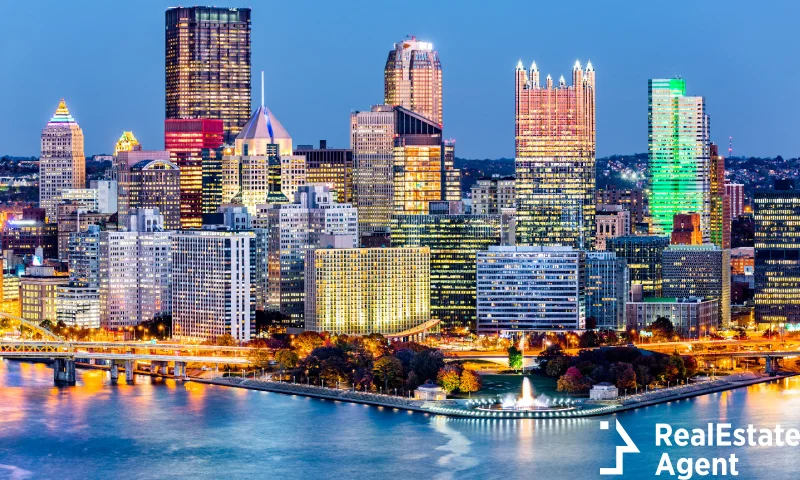Few people know, but “Steel City” isn’t just an industrial powerhouse. Pittsburgh, majestically located in Western Pennsylvania’s picturesque landscapes, is also a hub for charming suburbs. The “City of Champions” neighborhoods offer a seamless blend of community living and urban accessibility. Suppose you’re considering a move to Pittsburgh, PA. Or, you’re looking for a change of scenery within the region. In that case, these ten cities near Pittsburgh are worth your attention in 2024.
Table of Contents
- 1. Fox Chapel: Where Nature Meets Elegance
- 2. Aspinwall: A Quaint Riverside Retreat
- 3. Franklin Park: Suburban Serenity
- 4. Bradford Woods: Small-Town Charm
- 5. Marshall Township: A Suburban Gem
- 6. Mount Lebanon Township: Urban Sophistication in the Suburbs
- 7. Edgeworth: Historic Elegance
- 8. Upper St. Clair: Exceptional Schools, Exceptional Living
- 9. O’Hara Township: Tranquil Living Near the City
- 10. McMurray: The Suburban Oasis
1. Fox Chapel: Where Nature Meets Elegance
Known for its affluent atmosphere, Fox Chapel is a premier suburb near Pittsburgh. The neighborhood hosts luxurious homes nestled amidst lush greenery! Due to its unique environment, Fox Chapel provides a serene escape while keeping you close to Pittsburgh’s cultural heartbeat. Are you seeking an upscale and modern lifestyle close to nature? Then, you’re at the right place! The proximity to the Fox Chapel Golf Club and parks will undeniably enhance the quality of your life!
Cost of Living
According to Sperling’s BestPlaces, the cost of living index in Fox Chapel is 91.8. This means that the total cost of first-class health care, housing, food, child care, transportation, taxes, and other necessities is 8.2% lower than the US average. At the same time, it’s 3.0% higher than the average for Pennsylvania.
The median home sale price in Fox Chapel is $815,000 in January 2024. In the bigger context, Fox Chapel properties are 160% more expensive than the national average of $420,700. Simultaneously, they are about 260% more expensive than the average Pennsylvania home, at $242,800.
Renting a two-bedroom unit in Fox Chapel costs $1,200 monthly, 16% cheaper than the national average of $1,430. The state average is $1,210. To live comfortably in Fox Chapel, Pennsylvania, a minimum annual income of $168,120 for a family and $40,000 for a single person is recommended.
Demographics
Fox Chapel, Pennsylvania, a borough in Allegheny County and a suburb of Pittsburgh, has been experiencing a fluctuation in its population numbers in recent years. According to World Population Review, as of 2024, Fox Chapel’s population is 5,085, marking a decline of 4.65% from the 2020 census figure of 5,333.
This indicates an annual decline rate of -1.19%. The drop suggests fewer people are moving into the area or residents are moving out at a modest pace. On the other hand, Data USA indicates that between 2020 and 2021, Fox Chapel saw population growth from 5,104 to 5,314, a 4.11% increase. The good news is that the median household income also rose from $233,776 to $247,930. This growth phase suggests a brief period where the area experienced an influx of residents or increased birth rates over departures.
2. Aspinwall: A Quaint Riverside Retreat
Situated along the Allegheny River, Aspinwall is a charming town with historic architecture and a vibrant community. The town’s riverfront parks and local boutiques create a welcoming atmosphere. Aspinwall perfectly balances a peaceful suburban life and convenient access to Pittsburgh’s cultural amenities.
Cost of Living
You’ll find housing, food, child care, transportation, health care costs, taxes, and other necessities included in this index. A typical home in Aspinwall costs $345,700, which is 2.2% more expensive than the national average of $338,100. Plus, it’s costlier than the average Pennsylvania home ($242,800) by about 42.4%. Renting a two-bedroom unit in Aspinwall costs $1,120 monthly, 21.7% cheaper than the national average of $1,430. At the same time, it’s 8.0% more reasonable than the state average of $1,210.
To live and thrive comfortably in Aspinwall, Pennsylvania, we recommend setting aside a minimum annual income of $66,240 for families. If you’re single, $37,200 will be acceptable.
According to City Data, the cost of living index in Aspinwall as of March 2022 is 96.6, near the American average of 100. The cost of living in Aspinwall is 12% higher than the national average. The general sales tax in Pennsylvania is 18% higher than the national average. Simultaneously, the state income tax is 36% higher than the national average. AreaVibes reports that the cost of living in Aspinwall is 12% higher than the Pennsylvania average and 10% higher than the national average. The housing cost in Aspinwall is 26% higher than the national average.
Demographics
Despite this short-term growth, Aspinwall’s population has shown a long-term trend of decline. As of 2024, the population is recorded at 2,757, marking a decrease of 5.29% since the 2020 census. Then, the population peaked at 2,911. This -1.47 percent annual rate decline indicates that the recent growth spurt must be maintained. Furthermore, the borough is experiencing a net decrease over time.
We can explain this trend by rapidly changing housing market dynamics, local employment transitions, or demographic preference shifts. Despite these fluctuations, Aspinwall remains a community with a high average household income of $143,604. In addition, it boosts a relatively low poverty rate of 1.66%. All these add to the image of an affluent suburb within the Pittsburgh area.
3. Franklin Park: Suburban Serenity
Franklin Park is a charming town that features spacious homes and well-planned neighborhoods. Simply put, it’s a sanctuary for those seeking a quiet suburban lifestyle. However, the community atmosphere is genuinely vivid. Plus, the local schools are renowned for their excellence. Franklin Park represents a harmonious blend of comfort and convenience for families and individuals.
Cost of Living
Franklin Park is a booming suburb of Pittsburgh with a population of 15,305. The median home value in Franklin Park is $436,300, while the median rent is $1,940. The cost of living in Franklin Park is 1.2 percent higher than the national average. According to Sperling’s BestPlaces, the median home price in Franklin Park is $435,000, which is 22.3% higher than the national average. The median income in Franklin Park is $142,850, 51.7% lower than the Average Joe’s annual salary.
Demographics
More recent data from World Population Review indicates that as of 2024, Franklin Park’s population counted approximately 14,861 souls. As a result, we can notice a decrease of 3.97% from the 2020 census figure of 15,475. This represents an annual decline rate of -1.01%. In other words, a growth trend reversal can be observed. Despite this downturn, Franklin Park maintains a high average household income of $186,411 and a low poverty rate of 2.92%. Undoubtedly, we’re discussing a still well-off community.
The fluctuation in population highlights the dynamic nature of demographic changes. Most prominently, housing affordability, lifestyle shifts, and economic conditions influence the demographic turning points.
4. Bradford Woods: Small-Town Charm
If you crave the small-town delights, Bradford Woods is your answer. This close-knit community fosters a sense of belonging and offers picturesque landscapes. With its top-rated schools and parks, Bradford Woods is a family-friendly place, settling in a peaceful environment. At the same time, they won’t sacrifice proximity to the joys of the metropolitan lifestyle that Pittsburgh represents.
Cost of Living
Let’s start with the excellent news first! The total cost of food, housing, child care, transportation, health care, taxes, and other necessities is lower than the national average. Beware, though! The median home cost in Bradford Woods is $463,400, about 37.1% pricier than the national average. At the same time, it’s 90.9% more expensive than the average Pennsylvania home.
Renting a two-bedroom unit in Bradford Woods costs $1,690 monthly, 18.2% more than the national average. Unsurprisingly, it’s costlier than the state average by about 28.4%. To live happily in Bradford Woods, Pennsylvania, a family should have an annual income of $88,920. Simultaneously, we advise $56,000 for a single person.
Demographics
Data USA’s findings confirm a population decrease from 1,267 (2020) to 1,226 (2021), triggering a -3.24% change. However, during the same period, the median household income grew significantly from $121,389 to $141,304, a 16.4% increase. On the one hand, the population may be declining. On the other hand, Bradford Woods residents’ economic well-being is improving.
This way, we can notice a concentration of wealth or a demographic shift towards higher-earning complex households. Local demographic trends illustrate the complex interplay between small American towns’ population dynamics and economic factors.
5. Marshall Township: A Suburban Gem
Marshall Township boasts a mix of modern conveniences and natural beauty. With well-maintained parks and recreational facilities, residents can enjoy an active lifestyle. The suburb’s strategic location also makes it a commuter-friendly choice. If you decide to move here, you’ll benefit from easy access to major highways connecting you to downtown Pittsburgh.
Cost of Living
According to Niche, the cost of living index for Marshall Township is B-. Put another way, it’s 9% higher than the Pennsylvania average. The median home value in Marshall Township is $466,800, approximately 66.2% higher than the national average. The median rent in Marshall Township is $1,811 per month. So, you’ll have to pay 43.1 percent more expensive rent than the national average.
The crime rates in Marshall Township are 86% lower than the Pennsylvania average. Marshall Township’s livability score is 79/100, exceptional either way you put it. The median income for a household in Marshall Township is $92,820. Secondly, the median family income is $100,329. The per capita income for the borough is $51,462.
Demographics
Marshall Township’s stability in numbers indicates a resilient community. Here’s a fascinating piece of trivia! Pennsylvania grew by only 2.4% from 2010 to 2020. At the same time, Marshall Township’s population grew substantially more, from 6,900 (2010) to 10,080 (2020). These figures suggest that our lovely community has kept its residents. Plus, it attracted new ones at a rate that offsets departures.
The township can genuinely sustain its population amidst trends of slow growth. This fact sheds a positive light on its local economy, amenities, and living conditions. Stability is crucial for prospective residents and businesses. And the force is with Marshall Township! The suburb will be more desirable within the region in 2024 than ever!
6. Mount Lebanon Township: Urban Sophistication in the Suburbs
Mount Lebanon Township is the answer for those desiring urban amenities without the hustle and bustle of city life. This neighborhood offers a vibrant cultural scene, trendy boutiques, and excellent dining options. The well-preserved architecture and tree-lined streets create an idyllic setting for a sophisticated suburban lifestyle.
Cost of Living
Off the bat, the cost of living in Mount Lebanon Township is moderately expensive, with a cost of living index of 110.6. The cost of living in Lebanon is 10% lower than the Pennsylvania average and 10% lower than the national average. Secondly, the median home value is $350,800, and the median rent is $1,071. Thirdly, the general sales tax in Pennsylvania is 18% higher than the national average. The state income tax is 36% higher than the national average. These figures will give you a good idea of what to expect if you consider moving to Mount Lebanon Township, Pittsburgh, PA.
Demographics
Despite the community’s economic potential, 2024 statistics indicate a slight decrease in the population. Thus, we can observe a 1.03% decline from 34,019 (previous years) to 33,670 (2024). This trend might suggest a balancing act between incoming residents and those leaving for various reasons, including housing affordability, lifestyle changes, or job relocation. Despite this slight decline, Mount Lebanon remains an attractive destination for families and individuals. Suburban tranquility? Check! Urban convenience? Check! Economic vitality and community engagement? You bet! Don’t think twice about moving to this delightful tiny town! Here, everybody will become your best neighbor!
7. Edgeworth: Historic Elegance
Edgeworth shines grace and style with its historic homes ornated with the most stylish arboriculture. The community prides itself on preserving its rich history while embracing modern living. Why should you choose this adorable place? Because it showcases top-notch schools and a vigorous sense of community. As a result, Edgeworth will become a hidden gem for those seeking a blend of classic charm and contemporary comfort.
Cost of Living
The cost of living in Edgeworth, Pittsburgh, PA, is likely to be higher than the cost of living in Pittsburgh, PA. According to Sperling’s BestPlaces, the cost of living in Edgeworth is 91.8% of the national average. The median home cost in Edgeworth is $766,900. The estimated median income for a household in Edgeworth is $155,170.
Demographics
In 2024, Edgeworth’s population was 1,605, representing a decrease of 4.06% from 1,673 (2020). This trend indicates an annual decline rate of -1.11%. Can we confirm a substantial drop in the borough’s population in the future? Time will tell. Despite this demographic downturn, Edgeworth remains an affluent area. Let’s see the evidence! The average household income was a spectacular $324,718! Secondly, the community boasts a low poverty rate of 1.18%! The factors mentioned above indicate that Edgeworth continues to be a prosperous community with the best amenities, even with its shrinking population.
8. Upper St. Clair: Exceptional Schools, Exceptional Living
Recognized for its award-winning school district, Upper St. Clair is a magnet for families prioritizing education. The suburb offers a range of recreational facilities, including parks and sports complexes. All ensure residents a high quality of life. Excellent schools and a strong sense of community make Upper St. Clair a standout choice and a hidden gem of a college town.
Cost of Living
In 2024, Upper St. Clair has a cost of living score of 91.8. The median home cost in Upper St. Clair is $416,000, which is 23.0% more expensive than the national average ($338,100). At the same time, it’s 71.3% more expensive than the average Pennsylvania home ($242,800).
Renting a two-bedroom unit in Upper St. Clair costs $1,440 monthly, 0.7% more than the national average ($1,430). Also, it’s 16.0% more than the state average of $1,210. To live comfortably in Upper St. Clair, Pennsylvania, a minimum annual income of $79,560 for a family and $47,600 for a single person is recommended.
Demographics
The Township of Upper St. Clair, PA, has exhibited a pattern of steady population growth over the past two decades. Under such circumstances, it mirrors the broader demographic trends in the Pittsburgh metropolitan area. From 2000 to 2022, the population of Upper St. Clair Township increased by 901, reaching a peak of 21,134 in 2020.
This gradual growth indicates the town’s persistent appeal as a popular residential area. In 2024, Upper St. Clair is recognized thanks to its affluent status, high-quality school district, outstanding amenities, and desirable living conditions. So, what stops you from moving to one of the more sought-after suburbs of Pittsburgh?
9. O’Hara Township: Tranquil Living Near the City
O’Hara Township delivers a peaceful retreat while maintaining close ties to Steel City. The suburb’s parks and green spaces offer ample opportunities for peaceful strolls, meditation, and exciting outdoor activities. Do you appreciate being an active member of a friendly community? Does a convenient location to “The Burgh” figure high on your list of priorities? Do you want to be close to nature but preserve a socially well-connected lifestyle? If your answers are positive, then O’Hara Township will be your ideal relocation destination!
Cost of Living
O’Hara Township is a delightful suburb of Pittsburgh with a population of 9,206. The median home value in O’Hara Township is $350,700, higher than the national average of $281,900. The median rent in O’Hara Township is $1,815, which is also higher than the national standard of $1,268.
Niche graded the cost of living in O’Hara Township “B-“. Unfortunately, it’s lower than the national average. The cost of living in O’Hara Township is higher than the national average. Nonetheless, folks still consider living here more affordable than in other suburbs in the Pittsburgh Metro Area.
Demographics
O’Hara Township, Pennsylvania, has observed a gradual population change over recent years. In 2020, the township’s population was 9,274. In 2022, its population was 9,075. This number represents a 1.20% decrease from the previous year when the population stood at 9,185. And the most recent statistics indicate that the number of souls has risen again to 9,285 in 2024.
O’Hara Township saw an increase in residents over a broader period, from 2000 to 2024. Over two decades, this population expansion suggests a slow but positive growth trend. Moreover, it reflects the township’s ability to attract and retain residents. What is O Hara’s secret? The mystery lies in the exquisite quality of life, community services, and proximity to Pittsburgh’s economic opportunities.
10. McMurray: The Suburban Oasis
McMurray, south of Pittsburgh, is an outstanding residential oasis known for its ultra-family-friendly atmosphere. Many former Pittsburgh citizens chose McMurray because of its unabashedly green surroundings and incredible parks. Plus, its local schools consistently receive high ratings. McMurray has grown synonymous with a tranquil environment. At the same time, residents will be granted easy access to Pittsburgh and Washington County amenities.
Cost of Living
McMurray is a suburb of Pittsburgh with a population of 4,647. The cost of living in McMurray is graded B+ by BestPlaces, which is higher than the national average.
McMurray’s cost of living is 9.9% lower than the American average. Simultaneously, the median home price in McMurray is $362,100, about 7.1% more expensive than the US average of $338,100. The median rent in McMurray is $1,360 monthly, which is 4.9% cheaper than the national average of $1,430.
Demographics
World Population Review highlighted that McMurray’s 2024 population is 4,157. This figure indicates a minimal decrease of -0.24% since the 2020 census figure of 4,167. The present-day population stability contrasts with the earlier decline. Subsequently, we witness a balance and a slight recovery in McMurray’s demographic trends.
The average household income in McMurray has been notably high at $216,578. McMurray also boasts a spectacularly low poverty rate of 2.26%. These figures emphasize McMurray’s economic potential and appeal as an affluent community within Washington County, Pennsylvania.
The Bottom Line
We admit that picking our favorite from these ten fine Pittsburgh suburbs would be highly challenging. However, whichever you choose from these Steel City neighborhoods, all will offer a rich and satisfying tapestry of options. Each suburb possesses a distinct charm and comes with a set of extraordinary perks. For instance, Edgeworth will capture your heart with its historical allure! McMurray will sweep you off your feet with its family-oriented ambiance. And before jumping to any conclusion, experience Mount Lebanon Township’s cosmopolitan flair!
In 2024, these Pittsburgh suburbs maintain their allure as prominent residential destinations. Undoubtedly, they seamlessly balance the peacefulness of suburban living with the city’s dynamic energy. Navigating through Pittsburgh, PA, is a breeze. Suppose you decide to relocate soon. In that case, reputable moving companies in Pittsburgh ensure a smooth transition without any complications, making your move a hassle-free experience.















